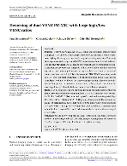| dc.contributor.author | Brunátová, Jana | |
| dc.contributor.author | Löcke, Miriam | |
| dc.contributor.author | Uribe, Sergio | |
| dc.contributor.author | Bertoglio, Cristóbal | |
| dc.date.accessioned | 2025-03-03T06:13:13Z | |
| dc.date.available | 2025-03-03T06:13:13Z | |
| dc.date.issued | 2024 | |
| dc.identifier.uri | https://hdl.handle.net/20.500.14178/2952 | |
| dc.description.abstract | Purpose: Dual velocity encoding PC-MRI can produce spurious artifacts whenusing high ratios of velocity encoding values (VENCs), limiting its ability to gen-erate high-quality images across a wide range of encoding velocities. This studyaims to propose and compare dual-VENC correction methods for such artifacts. Theory and Methods: Two denoisingapproachesbasedonspatiotemporalreg-ularization are proposed and compared with a state-of-the-art method based onsign correction. Accuracy is assessed using simulated data from an aorta andbrain aneurysm, as well as 8 two-dimensional (2D) PC-MRI ascending aortadatasets. Two temporal resolutions (30,60) ms and noise levels (9,12) dB areconsidered, with noise added to the complex magnetization. The error is evalu-ated with respect to the noise-free measurement in the synthetic case and to theunwrapped image without additional noise in the volunteer datasets. Results: In all studied cases, the proposed methods are more accurate than theSign Correction technique. Using simulated 2D+T data from the aorta (60 ms,9 dB), the Dual-VENC (DV) error 0.82 +/- 0.07 is reduced to: 0.66 +/- 0.04 (SignCorrection);0.34 +/- 0.04and0.32 +/- 0.04(proposedtechniques).Themethodsarefound to be significantly different (p-value<0.05). Importantly, brain aneurysmdatarevealedthattheSignCorrectionmethodisnotsuitable,asitincreaseserrorwhen the flow is not unidirectional. All three methods improve the accuracy ofin vivo data. Conclusion:The newly proposed methods outperform the Sign Correctionmethod in improving dual-VENC PC-MRI images. Among them, the approachbased on temporal differences has shown the highest accuracy. | en |
| dc.language.iso | en | |
| dc.relation.url | https://doi.org/10.1002/mrm.30278 | |
| dc.rights | Creative Commons Uveďte původ 4.0 International | cs |
| dc.rights | Creative Commons Attribution 4.0 International | en |
| dc.title | Denoising of dual-VENC PC-MRI with large high/low VENC ratios | en |
| dcterms.accessRights | openAccess | |
| dcterms.license | https://creativecommons.org/licenses/by/4.0/legalcode | |
| dc.date.updated | 2025-03-03T06:13:13Z | |
| dc.subject.keyword | denoising | en |
| dc.subject.keyword | dual-VENC | en |
| dc.subject.keyword | phase-contrast MRI | en |
| dc.subject.keyword | | en |
| dc.identifier.eissn | 1522-2594 | |
| dc.relation.fundingReference | info:eu-repo/grantAgreement/UK/GAUK/GAUK308522 | |
| dc.relation.fundingReference | info:eu-repo/grantAgreement/UK/COOP/COOP | |
| dc.date.embargoStartDate | 2025-03-03 | |
| dc.type.obd | 73 | |
| dc.type.version | info:eu-repo/semantics/publishedVersion | |
| dc.identifier.doi | 10.1002/mrm.30278 | |
| dc.identifier.utWos | 001314786600001 | |
| dc.identifier.eidScopus | 2-s2.0-85204242485 | |
| dc.identifier.obd | 652754 | |
| dc.identifier.pubmed | 39290071 | |
| dc.subject.rivPrimary | 10000::10100::10102 | |
| dcterms.isPartOf.name | Magnetic Resonance in Medicine | |
| dcterms.isPartOf.issn | 0740-3194 | |
| dcterms.isPartOf.journalYear | 2024 | |
| dcterms.isPartOf.journalVolume | Volume 93 | |
| dcterms.isPartOf.journalIssue | January 2025 | |
| uk.faculty.primaryId | 116 | |
| uk.faculty.primaryName | Matematicko-fyzikální fakulta | cs |
| uk.faculty.primaryName | Faculty of Mathematics and Physics | en |
| uk.department.primaryId | 1315 | |
| uk.department.primaryName | Matematický ústav UK | cs |
| uk.department.primaryName | Mathematical Institute of Charles University | en |
| dc.description.pageRange | 353-368 | |
| dc.type.obdHierarchyCs | ČLÁNEK V ČASOPISU::článek v časopisu::původní článek | cs |
| dc.type.obdHierarchyEn | JOURNAL ARTICLE::journal article::original article | en |
| dc.type.obdHierarchyCode | 73::152::206 | en |
| uk.displayTitle | Denoising of dual-VENC PC-MRI with large high/low VENC ratios | en |

